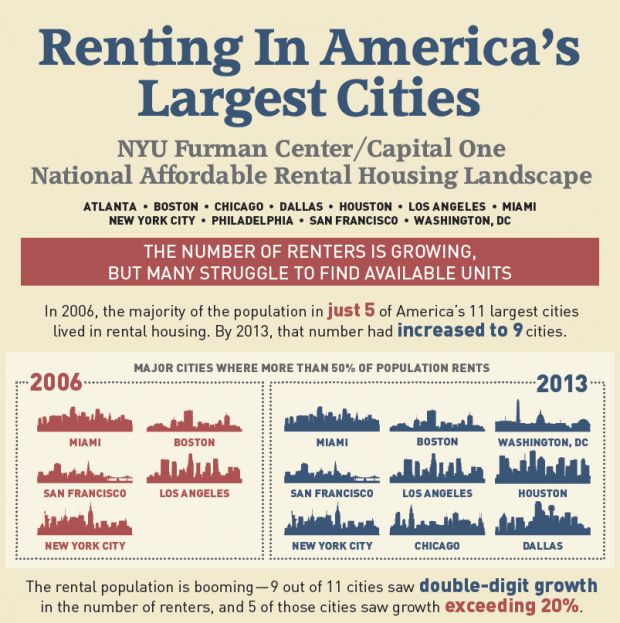A report by New York University’s Furman Center found that renters made up the majority of households in nine of the 11 largest cities in the U.S. in 2013, up from five in 2006. The demand is straining the supply of rental housing.
The report, produced with Capital One's "Investing for Good" subsidiary, "found a significant shift in the proportion of renters in all major cities—even in lower-density, relatively inexpensive places such as Houston and Dallas," write Wall Street Journal reporters Laura Kusisto and Kris Hudson.

One surprising outlier was the nation's largest city, which "no longer has the largest share of renters of any of the big cities, having been outstripped by Miami, where 65% of the population rents, a percentage point higher than New York [see Wall Street Journal graphic]," write Kusisto and Hudson. New York "is also one of several where the percentage of renters has been on a long-term decline, falling from 71% in 1970 to 64% in 2013."
Causes for the major uptick in renting nationwide varies. In some, "long-term demographic trends and changing attitudes have diminished the appeal of the traditional American dream of homeownership," they write. "But for many, slow income growth and a lack of savings are the main reasons for renting instead of buying, even as mortgage rates remain historically low."
The implications on affordable housing was one of the main findings of the report. "As the number of renters grow, if the supply of rental housing does not keep up—as it has not in most of these cities—then vacancy rates will fall, rents will rise, and more renters will struggle with the costs of housing," said Ingrid Gould Ellen, the Furman Center’s faculty director.
The report found that rents rose faster than household incomes in five of the cities and "outpaced inflation in all of the 11 cities except for Dallas and Houston, where they remained largely flat," write Kusisto and Hudson. "Rents rose the most in Washington, D.C., over the seven-year period."
View the findings of the report or the press release.
A full report with the city-specific data will be available in mid-February. To receive a copy by email, please join the NYU Furman Center mailing list.
FULL STORY: Renters Are Majority in Big U.S. Cities Even Relatively Inexpensive Places Move Away From Homeownership

Maui's Vacation Rental Debate Turns Ugly
Verbal attacks, misinformation campaigns and fistfights plague a high-stakes debate to convert thousands of vacation rentals into long-term housing.

Planetizen Federal Action Tracker
A weekly monitor of how Trump’s orders and actions are impacting planners and planning in America.

In Urban Planning, AI Prompting Could be the New Design Thinking
Creativity has long been key to great urban design. What if we see AI as our new creative partner?

Cal Fire Chatbot Fails to Answer Basic Questions
An AI chatbot designed to provide information about wildfires can’t answer questions about evacuation orders, among other problems.

What Happens if Trump Kills Section 8?
The Trump admin aims to slash federal rental aid by nearly half and shift distribution to states. Experts warn this could spike homelessness and destabilize communities nationwide.

Sean Duffy Targets Rainbow Crosswalks in Road Safety Efforts
Despite evidence that colorful crosswalks actually improve intersection safety — and the lack of almost any crosswalks at all on the nation’s most dangerous arterial roads — U.S. Transportation Secretary Duffy is calling on states to remove them.
Urban Design for Planners 1: Software Tools
This six-course series explores essential urban design concepts using open source software and equips planners with the tools they need to participate fully in the urban design process.
Planning for Universal Design
Learn the tools for implementing Universal Design in planning regulations.
Appalachian Highlands Housing Partners
Gallatin County Department of Planning & Community Development
Heyer Gruel & Associates PA
Mpact (founded as Rail~Volution)
City of Camden Redevelopment Agency
City of Astoria
City of Portland
City of Laramie





























